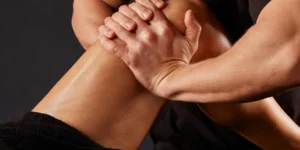Let’s be honest: the name deep tissue massage doesn’t exactly sound like something you’d book for a chill spa day. And to be fair, it’s not. But if you’ve ever dealt with stubborn muscle pain, tension that won’t go away, or that “stuck” feeling in your body that stretching can’t fix—deep tissue work might be exactly what you need.
I’m Cameron Rueda, a certified sports massage therapist based in Montreal, and I work with all kinds of bodies—runners, lifters, cyclists, climbers, boxers, weekend warriors, folks who sit at a desk all day, and people who’ve just had enough of living in discomfort. One of the most common things I get asked in clinic is: What is deep tissue massage, and is it supposed to feel like this?
Let’s break it down—without the fluff.
What Deep Tissue Massage Actually Is
A lot of people assume deep tissue just means “hard pressure,” but that’s not quite right.
Deep tissue massage is about working through the outer layers of muscle to reach deeper structures—like fascia (the connective tissue that wraps around everything), chronic knots, and long-standing muscular tension that’s affecting how you move and feel. It’s slow, deliberate, and focused.
Sometimes I use my thumbs. Sometimes elbows. Occasionally a fist if I need more leverage. But the point isn’t to hurt you—it’s to help your body release old holding patterns and start functioning the way it’s supposed to.
If you’ve ever felt like your body is compensating—maybe your hip is doing all the work your glute should be doing, or your shoulder is always “grabbing” even after stretching—this type of work can help reset the system.
Who It’s For (Hint: It’s Not Just Athletes)
I work with a lot of athletes and active people, but deep tissue massage isn’t reserved for elite runners or bodybuilders. Honestly, some of the tightest, most tension-filled tissue I see comes from people who sit at a desk 40+ hours a week.
Here are a few folks who usually benefit from deep tissue work:
Runners dealing with tight hips or IT bands
Desk workers with stiff necks and sore upper backs
New parents with sore lower backs from carrying babies and lifting awkward car seats
Lifters with limited shoulder mobility
Anyone with chronic tension, especially in the traps, glutes, or low back
People recovering from surgery or injury who need help breaking down scar tissue
You don’t need to be in pain to benefit from deep tissue massage, either. A lot of my clients use it as part of their recovery routine to stay loose, mobile, and injury-free.
What to Expect in a Deep Tissue Session
I get it—if you’ve never had a deep tissue massage before, it can sound a little intimidating.
Here’s what usually happens: when you come into my space in Montreal, we’ll chat first. I want to understand what’s going on—what hurts, how long it’s been hurting, how it’s affecting your life. Then we get to work.
I always warm up the tissue first before diving deeper. That helps your body ease into it and reduces the “defense” response. The work is slow, intentional, and focused on the areas that need it most. I might stay in one spot for a while—waiting for the muscle to release instead of just hammering it. I may also do some movement-based work to help you integrate the changes.
It’s not about smashing tissue—it’s about listening to it and working with it.
Yes, it can be uncomfortable. But it should never feel sharp or unsafe. I always encourage clients to speak up. Communication is part of the process.
After the session, some people feel light and open right away. Others feel sore like they had a good workout. I always recommend drinking water, taking it easy for a bit, and maybe going for a short walk later to help the tissue settle into its new patterns.
What Deep Tissue Massage Can Help With
You don’t need to be dealing with something dramatic to benefit from this kind of work. A lot of the time, it’s the slow build-up of tension over weeks or months that leads to discomfort. Deep tissue massage can help:
Relieve chronic muscle tension and knots
Improve posture by releasing compensations
Increase range of motion in stiff joints
Reduce pain in the neck, shoulders, back, hips, and legs
Break up scar tissue after surgery or injury
Support athletic performance and faster recovery
Calm the nervous system (yes, even with deep pressure)
I’ve had clients tell me they didn’t realize how much they were bracing their body until they felt what it was like to let go.
Why Technique Matters More Than Pressure
It’s not just about going deeper—it’s about going smarter.
Deep tissue massage, when done properly, isn’t brute force. It’s about finding the right angle, the right tempo, the right amount of pressure for you in that moment. I work slowly to give your nervous system time to adjust. No one should leave a session feeling beat up. This is about helping your body—not punishing it.
Is It Safe?
For most people, yes. But if you have a recent injury, inflammation, a bleeding disorder, or are taking blood thinners, we’ll want to take a more cautious approach—or explore other modalities first. I always do a thorough intake and will never push past what your body is ready for.
The Montreal Deep Tissue Difference
I’m based in Montreal and I bring a sports therapy lens to everything I do. That means I’m not just thinking about how your body feels during the session, but how it functions when you’re back out in the real world—whether that’s training for a half-marathon, lifting your kid without pain, or sitting through a Zoom meeting without your traps lighting up.
Massage is part of your larger care plan. It works best when we treat it as a conversation—your body speaks, and together, we listen and respond.
Final Thoughts
Deep tissue massage therapy isn’t for everyone—but if you’re looking for something beyond the surface, something that can help shift the way your body feels, moves, and performs, it might be worth exploring.
You don’t have to live in pain. You don’t have to “just deal with it.” And you don’t need to wait until things get worse.
If you’re in Montreal and you’re curious about whether deep tissue massage is right for you, reach out. I’d be happy to talk it through—or better yet, show you what it can do.
Book your session today and let’s get your body moving the way it was meant to.







